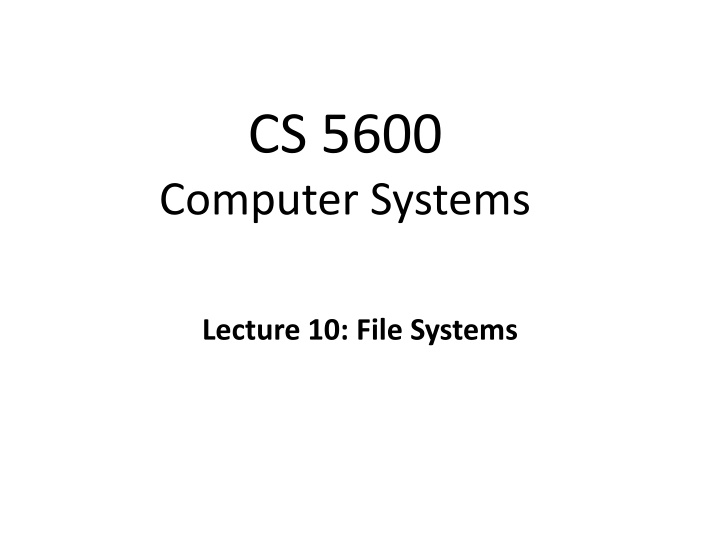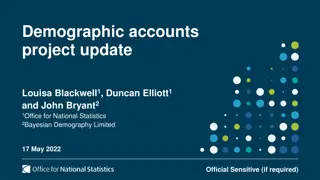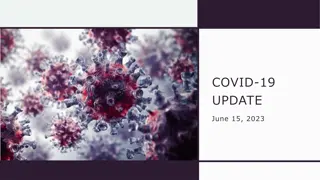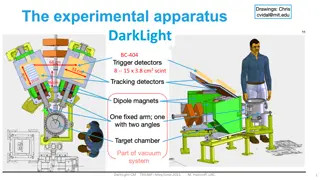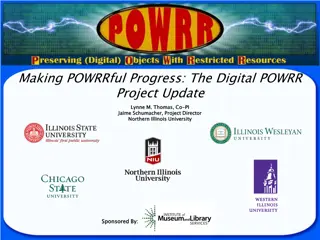EURIZON Research Project Update June 2023
The EURIZON research project involves collaboration on synchrotrons and lepton colliders with key developments in vacuum chamber impedances, beam instabilities, and linac development. Results and milestones from Task 4.3 and Task 4.4 are highlighted, along with deliverables and the proposed linac layout presented at the annual meeting. Key reports and workshops are outlined for completion by the project end date in February 2024.
Download Presentation

Please find below an Image/Link to download the presentation.
The content on the website is provided AS IS for your information and personal use only. It may not be sold, licensed, or shared on other websites without obtaining consent from the author.If you encounter any issues during the download, it is possible that the publisher has removed the file from their server.
You are allowed to download the files provided on this website for personal or commercial use, subject to the condition that they are used lawfully. All files are the property of their respective owners.
The content on the website is provided AS IS for your information and personal use only. It may not be sold, licensed, or shared on other websites without obtaining consent from the author.
E N D
Presentation Transcript
CS 5600 Computer Systems Lecture 10: File Systems
What are We Doing Today? Last week we talked extensively about hard drives and SSDs How they work Performance characteristics This week is all about managing storage Disks/SSDs offer a blank slate of empty blocks How do we store files on these devices, and keep track of them? How do we maintain high performance? How do we maintain consistency in the face of random crashes? 2
Partitions and Mounting Basics (FAT) inodes and Blocks (ext) Block Groups (ext2) Journaling (ext3) Extents and B-Trees (ext4) Log-based File Systems 3
Building the Root File System One of the first tasks of an OS during bootup is to build the root file system 1. Locate all bootable media Internal and external hard disks SSDs Floppy disks, CDs, DVDs, USB sticks 2. Locate all the partitions on each media Read MBR(s), extended partition tables, etc. 3. Mount one or more partitions Makes the file system(s) available for access 4
The Master Boot Record Address Size (Bytes) Description Includes the starting LBA and length of the partition Hex Dec. 0x000 0 Bootstrap code area 446 0x1BE 446 Partition Entry #1 16 0x1CE 462 Partition Entry #2 16 0x1DE 478 Partition Entry #3 16 0x1EE 494 Partition Entry #4 16 0x1FE 510 Magic Number 2 Total: 512 Disk 1 Partition 1 (ext3) Partition 2 (swap) Partition 3 (NTFS) Partition 4 (FAT32) MBR Disk 2 Partition 1 (NTFS) MBR 5
Extended Partitions In some cases, you may want >4 partitions Modern OSes support extended partitions Logical Partition 1 Logical Partition 2 (NTFS) Disk 1 Partition 1 (ext3) Partition 2 (swap) Partition 3 (Extended Partition) (NTFS) Partition 4 (FAT32) Ext. Part. MBR Extended partitions may use OS-specific partition table formats (meta-data) Thus, other OSes may not be able to read the logical partitions 6
Types of Root File Systems Windows exposes a multi-rooted system Each device and partition is assigned a letter Internally, a single root is maintained Linux has a single root One partition is mounted as / All other partitions are mounted somewhere under / Typically, the partition containing the kernel is mounted as / or C: [cbw@ativ9 ~] df -h Filesystem /dev/sda7 /dev/sda2 296M 48M 249M /dev/sda5 127G 86G /dev/sda4 61G 34G /dev/sdb1 1.9G 352K 1.9G Size Used Avail Use% Mounted on 39G 14G 23G 1 drive, 4 partitions 38% / 16% /boot/efi 68% /media/cbw/Data 57% /media/cbw/Windows 1% /media/cbw/NDSS-2013 42G 27G 1drive, 1 partition 7
Mounting a File System 1. Read the super block for the target file system Contains meta-data about the file system Version, size, locations of key structures on disk, etc. 2. Determine the mount point On Windows: pick a drive letter On Linux: mount the new file system under a specific directory Filesystem /dev/sda5 127G 86G /dev/sda4 /dev/sdb1 1.9G 352K 1.9G Size Used Avail Use% Mounted on 42G 61G 34G 27G 68% /media/cbw/Data 57% /media/cbw/Windows 1% /media/cbw/NDSS-2013 8
Virtual File System Interface Problem: the OS may mount several partitions containing different underlying file systems It would be bad if processes had to use different APIs for different file systems Linux uses a Virtual File System interface (VFS) Exposes POSIX APIs to processes Forwards requests to lower-level file system specific drivers Windows uses a similar system 9
VFS Flowchart Processes (usually) don t need to know about low- level file system details Relatively simple to add additional file system drivers Process 1 Process 2 Process 3 Virtual File System Interface Kernel ext3 Driver FAT32 Driver NTFS Driver ext3 Partition NTFS Partition FAT32 Partition 10
Mount isnt Just for Bootup When you plug storage devices into your running system, mount is executed in the background Example: plugging in a USB stick What does it mean to safely eject a device? Flush cached writes to that device Cleanly unmount the file system on that device 11
Partitions and Mounting Basics (FAT) inodes and Blocks (ext) Block Groups (ext2) Journaling (ext3) Extents and B-Trees (ext4) Log-based File Systems 12
Status Check At this point, the OS can locate and mount partitions Next step: what is the on-disk layout of the file system? We expect certain features from a file system Named files Nested hierarchy of directories Meta-data like creation time, file permissions, etc. How do we design on-disk structures that support these features? 13
The Directory Tree cs5600 cbw home bin python / (root) tmp amislove Navigated using a path E.g. /home/amislove/music.mp3 14
Absolute and Relative Paths Two types of file system paths Absolute Full path from the root to the object Example: /home/cbw/cs5600/hw4.pdf Example: C:\Users\cbw\Documents\ Relative OS keeps track of the working directory for each process Path relative to the current working directory Examples [working directory = /home/cbw]: syllabus.docx [ /home/cbw/syllabus.docx] cs5600/hw4.pdf [ /home/cbw/cs5600/hw4.pdf] ./cs5600/hw4.pdf [ /home/cbw/cs5600/hw4.pdf] ../amislove/music.mp3 [ /home/amislove/music.mp3] 15
Files A file is a composed of two components The file data itself One or more blocks (sectors) of binary data A file can contain anything Meta-data about the file Name, total size What directory is it in? Created time, modified time, access time Hidden or system file? Owner and owner s group Permissions: read/write/execute 16
File Extensions File name are often written in dotted notation E.g. program.exe, image.jpg, music.mp3 A file s extension does not mean anything Any file (regardless of its contents) can be given any name or extension Has the data in the file changed from music to an image? Rename Graphical shells (like Windows explorer) use extensions to try and match files programs This mapping may fail for a variety of reasons 17
More File Meta-Data Files have additional meta-data that is not typically shown to users Unique identifier (file names may not be unique) Structure that maps the file to blocks on the disk Managing the mapping from files to blocks is one of the key jobs of the file system Disk 18
Mapping Files to Blocks Every file is composed of >=1 blocks Key question: how do we map a file to its blocks? As (start, length) pairs List of blocks [6] (9, 1) [1] [4, 5, 7, 8] (1, 1) (4, 4) 0 1 0 1 2 3 4 5 6 7 8 9 2 3 4 5 6 7 8 9 Problem? Fragmentation E.g. try to add a new file with 3 blocks Problem? Really large files 19
Directories Traditionally, file systems have used a hierarchical, tree-structured namespace Directories are objects that contain other objects i.e. a directory may (or may not) have children Files are leaves in the tree By default, directories contain at least two entries . self pointer .. points the the parents directory . .. bin / (root) 20 python
More on Directories Directories have associated meta-data Name, number of entries Created time, modified time, access time Permissions (read/write), owner, and group The file system must encode directories and store them on the disk Typically, directories are stored as a special type of file File contains a list of entries inside the directory, plus some meta-data for each entry 21
Example Directory File Windows C:\ Name Index Dir? Perms . 2 Y rwx Users Windows 3 Y rwx Users 4 Y rwx pagefile.sys 5 N r pagefile.sys 0 1 2 3 4 5 6 7 8 9 Disk C:\ 22
Directory File Implementation Each directory file stores many entries Key Question: how do you encode the entries? Sorted List of Entries Unordered List of Entries Other alternatives: hash tables, B-trees More on B-trees later In practice, implementing directory files is complicated Example: do filenames have a fixed, maximum length or variable length? Name Index Dir? Perms Name Index Dir? Perms . 2 Y rwx . 2 Y rwx Windows 3 Y rwx pagefile.sys 5 N r Users 4 Y rwx Users 4 Y rwx pagefile.sys 5 N r Windows 3 Y rwx Good: O(1) to add new entries Just append to the file Bad: O(n) to search for an entry Good: O(log n) to search for an entry Bad: O(n) to add new entries Entire file has the be rewritten
File Allocation Tables (FAT) Simple file system popularized by MS-DOS First introduced in 1977 Most devices today use the FAT32 spec from 1996 FAT12, FAT16, VFAT, FAT32, etc. Still quite popular today Default format for USB sticks and memory cards Used for EFI boot partitions Name comes from the index table used to track directories and files 24
Stores basic info about the file system FAT version, location of boot files Total number of blocks Index of the root directory in the FAT File allocation table (FAT) Marks which blocks are free or in-use Linked-list structure to manage large files Store file and directory data Each block is a fixed size (4KB 64KB) Files may span multiple blocks Super Block Disk 25
Directories are special files File contains a list of entries inside the directory Possible values for FAT entries: 0 entry is empty 1 reserved by the OS 1 < N < 0xFFFF next block in a chain 0xFFFF end of a chain Windows C:\ Users 2 3 4 5 6 7 8 9 2 3 4 5 6 7 8 9 Super Block Disk C:\ Name Index Dir? Perms Root directory index = 2 . 2 Y rwx Windows 3 Y rwx Users 4 Y rwx pagefile.sys 5 N r 26
Fat Table Entries len(FAT) == Number of clusters on the disk Max number of files/directories is bounded Decided when you format the partition The FAT version roughly corresponds to the size in bits of each FAT entry E.g. FAT16 each FAT entry is 16 bits More bits larger disks are supported 27
Fragmentation Blocks for a file need not be contiguous 60 61 62 63 56 57 58 59 64 65 67 68 FAT 0xFF FF 0 0 58 0 0 65 0 0 67 61 0 60 61 62 63 56 57 58 59 64 65 67 68 Blocks Possible values for FAT entries: 0 entry is empty 1 < N < 0xFFFF next block in a chain 0xFFFF end of a chain 28
FAT: The Good and the Bad The Good FAT supports: Hierarchical tree of directories and files Variable length files Basic file and directory meta-data The Bad At most, FAT32 supports 2TB disks Locating free chunks requires scanning the entire FAT Prone to internal and external fragmentation Large blocks internal fragmentation Reads require a lot of random seeking 29
Lots of Seeking FAT may have very low spatial locality, thus a lot of random seeking Consider the following code: int fd = open( my_file.txt , r ); int r = read(fd, buffer, 1024 * 4 * 4); // 4 4KB blocks 60 61 62 63 56 57 58 59 64 65 67 68 FAT 63 0 56 57 0xFF FF 0xFF FF 67 0 0 0 59 60 60 61 62 63 56 57 58 59 64 65 67 68 Blocks 30
Partitions and Mounting Basics (FAT) inodes and Blocks (ext) Block Groups (ext2) Journaling (ext3) Extents and B-Trees (ext4) Log-based File Systems 31
Status Check At this point, we have on-disk structures for: Building a directory tree Storing variable length files But, the efficiency of FAT is very low Lots of seeking over file chains in FAT Only way to identify free space is to scan over the entire FAT Linux file system uses more efficient structures Extended File System (ext) uses index nodes (inodes) to track files and directories 32
Size Distribution of Files FAT uses a linked list for all files Simple and uniform mechanism but, it is not optimized for short or long files Question: are short or long files more common? Studies over the last 30 years show that short files are much more common 2KB is the most common file size Average file size is 200KB (biased upward by a few very large files) Key idea: optimize the file system for many small files 33
Super block, storing: Size and location of bitmaps Number and location of inodes Number and location of data blocks Index of root inodes Table of inodes Each inode is a file/directory Includes meta-data and lists of associated data blocks Bitmap of free & used data blocks Bitmap of free & used inodes Data blocks (4KB each) 34
Directories are files Contains the list of entries in the directory bin Name Each inode can directly point to 12 blocks Can also indirectly point to blocks at 1, 2, and 3 levels of depth inode / . 0 cbw home bin 1 home 2 initrd.img 3 Inode Bitmap Data Bitmap Inodes Data Blocks SB Root inode = 0 35
ext2 inodes Size (bytes) Name What is this field for? 2 mode Read/write/execute? 2 uid User ID of the file owner 4 size Size of the file in bytes 4 time Last access time 4 ctime Creation time 4 mtime Last modification time 4 dtime Deletion time 2 gid Group ID of the file 2 links_count How many hard links point to this file? 4 blocks How many data blocks are allocated to this file? 4 flags File or directory? Plus, other simple flags 60 block 15 direct and indirect pointers to data blocks 36
inode Block Pointers Each inode is the root of an unbalanced tree of data blocks inode 15 total pointers Triple Indirect Double Indirect Single Indirect 12 blocks * 4KB = 48KB 230 blocks * 4KB = 4TB 1024 blocks * 4KB = 4MB 1024 * 1024 blocks * 4KB = 4GB 37
Advantages of inodes Optimized for file systems with many small files Each inode can directly point to 48KB of data Only one layer of indirection needed for 4MB files Faster file access Greater meta-data locality less random seeking No need to traverse long, chained FAT entries Easier free space management Bitmaps can be cached in memory for fast access inode and data space handled independently 38
File Reading Example Bitmaps inodes Data Blocks data inode root tmp file root tmp file[0] file[1] file[3] read open( /tmp/file ) read read read read Update the last accessed time of the file read Time read read() write read read read() write read read read() write
Bitmaps inodes Data Blocks File Create and Write Example data inode root tmp file root tmp file[0] read read read open( /tmp/file ) read read write Update the modified time of the directory write write write Time read read write() write write write
ext2 inodes, Again Size (bytes) Name What is this field for? 2 mode Read/write/execute? 2 uid User ID of the file owner 4 size Size of the file in bytes 4 time Last access time 4 ctime Creation time 4 mtime Last modification time 4 dtime Deletion time 2 gid Group ID of the file 2 links_count How many hard links point to this file? 4 blocks How many data blocks are allocated to this file? 4 flags File or directory? Plus, other simple flags 60 block 15 direct and indirect pointers to data blocks 41
Hard Link Example Multiple directory entries may point to the same inode [amislove@ativ9 ~] ln T ../cbw/my_file cbw_file cbw my_file 1. Add an entry to the amislove directory 2. Increase the link_count of the my_file inode home amislove cbw_file Inode Bitmap Data Bitmap Inodes Data Blocks SB 42
Hard Link Details Hard links give you the ability to create many aliases of the same underlying file Can be in different directories Target file will not be marked invalid (deleted) until link_count == 0 This is why POSIX delete is called unlink() Disadvantage of hard links Inodes are only unique within a single file system Thus, can only point to files in the same partition 43
Soft Links Soft links are special files that include the path to another file Also known as symbolic links On Windows, known as shortcuts File may be on another partition or device 44
Soft Link Example [amislove@ativ9 ~] ln s ../cbw/my_file cbw_file cbw my_file 1. Create a soft link file 2. Add it to the current directory home amislove cbw_file Inode Bitmap Data Bitmap Inodes Data Blocks SB 45
ext: The Good and the Bad The Good ext file system (inodes) support: All the typical file/directory features Hard and soft links More performant (less seeking) than FAT The Bad: poor locality ext is optimized for a particular file size distribution However, it is not optimized for spinning disks inodes and associated data are far apart on the disk! Inode Bitmap Data Bitmap Inodes Data Blocks SB 46
Partitions and Mounting Basics (FAT) inodes and Blocks (ext) Block Groups (ext2) Journaling (ext3) Extents and B-Trees (ext4) Log-based File Systems 47
Status Check At this point, we ve moved from FAT to ext inodes are imbalanced trees of data blocks Optimized for the common case: small files Problem: ext has poor locality inodes are far from their corresponding data This is going to result in long seeks across the disk Problem: ext is prone to fragmentation ext chooses the first available blocks for new data No attempt is made to keep the blocks of a file contiguous 48
Fast File System (FFS) FFS developed at Berkeley in 1984 First attempt at a disk aware file system i.e. optimized for performance on spinning disks Observation: processes tend to access files that are in the same (or close) directories Spatial locality Key idea: place groups of directories and their files into cylinder groups Introduced into ext2, called block groups 49
Block Groups In ext, there is a single set of key data structures One data bitmap, one inode bitmap One inode table, one array of data blocks In ext2, each block group contains its own key data structures Inode Bitmap Data Bitmap Inodes Data Blocks Block Group 1 Block Group 2 Block Group 3 Block Group 4 Block Group 5 Block Group 6 SB 50
